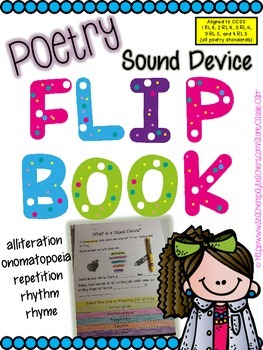Sound Devices in Poetry Flip-book
Cassie Carr
1.5k Followers
Grade Levels
1st - 4th
Subjects
Resource Type
Standards
CCSSRL.1.4
CCSSRL.2.4
CCSSRL.3.4
CCSSRL.3.5
CCSSRL.4.5
Formats Included
- PDF
Pages
29 pages
Cassie Carr
1.5k Followers
Description
This interactive flipbook is the perfect note taker for engaging students in their learning of sound devices used in poetry!
What You Get:
1. Detailed How-to Use Guide (pictures included)
2. Common Core Alignment- list of related standards in grades 1-4.
3. Essential Questions (1. How do poets play with words? 2. How is poetry different than prose, and 3. Why is language and word choice important in poetry?)
4. Key Vocabulary Posters- included terms are: poetry, line of poetry, stanzas, sound devices, alliteration, onomatopoeia, repetition, rhythm, and rhyme.
5. Student Flipbook pages (6 total)
6. Teacher Flipbook Answer Key (6 total)
How To Use:
1. Copy pages 17-22. Staple all 6 pages together at the top.
2. Students cut on dashed lines to create the layered flipbook pages.
3. Students color the flipbook pages different colors.
4. Students fill in the note taker with teacher modeling. Use teacher answer key on pages 23-28.
5. Have fun and please leave feedback!
What You Get:
1. Detailed How-to Use Guide (pictures included)
2. Common Core Alignment- list of related standards in grades 1-4.
3. Essential Questions (1. How do poets play with words? 2. How is poetry different than prose, and 3. Why is language and word choice important in poetry?)
4. Key Vocabulary Posters- included terms are: poetry, line of poetry, stanzas, sound devices, alliteration, onomatopoeia, repetition, rhythm, and rhyme.
5. Student Flipbook pages (6 total)
6. Teacher Flipbook Answer Key (6 total)
How To Use:
1. Copy pages 17-22. Staple all 6 pages together at the top.
2. Students cut on dashed lines to create the layered flipbook pages.
3. Students color the flipbook pages different colors.
4. Students fill in the note taker with teacher modeling. Use teacher answer key on pages 23-28.
5. Have fun and please leave feedback!
Total Pages
29 pages
Answer Key
Included
Teaching Duration
1 Week
Report this resource to TPT
Reported resources will be reviewed by our team. Report this resource to let us know if this resource violates TPT’s content guidelines.
Standards
to see state-specific standards (only available in the US).
CCSSRL.1.4
Identify words and phrases in stories or poems that suggest feelings or appeal to the senses.
CCSSRL.2.4
Describe how words and phrases (e.g., regular beats, alliteration, rhymes, repeated lines) supply rhythm and meaning in a story, poem, or song.
CCSSRL.3.4
Determine the meaning of words and phrases as they are used in a text, distinguishing literal from nonliteral language.
CCSSRL.3.5
Refer to parts of stories, dramas, and poems when writing or speaking about a text, using terms such as chapter, scene, and stanza; describe how each successive part builds on earlier sections.
CCSSRL.4.5
Explain major differences between poems, drama, and prose, and refer to the structural elements of poems (e.g., verse, rhythm, meter) and drama (e.g., casts of characters, settings, descriptions, dialogue, stage directions) when writing or speaking about a text.





